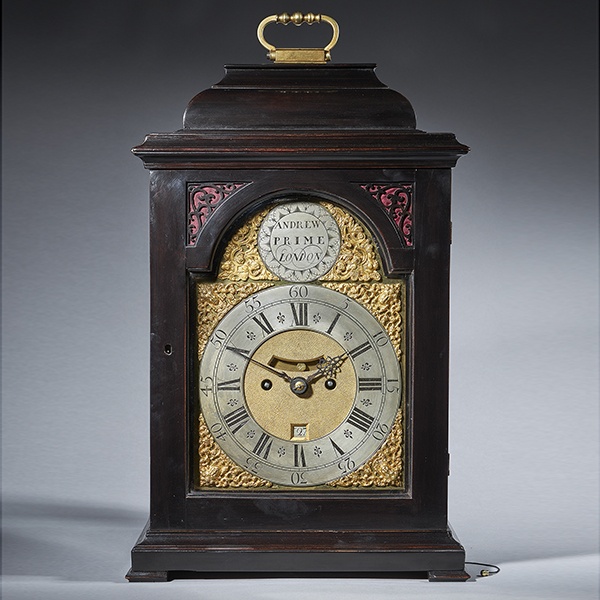17th Century William & Mary Walnut Strongbox or Coffre Fort, Circa 1680-1700
Sold
Request Information
Follow Us
17th Century William & Mary Walnut Strongbox or Coffre Fort, Circa 1680-1700
17th century William and Mary Period walnut strongbox or coffre fort.
A fine and rare walnut strongbox or coffre fort of unusual small proportions, adorned with highly decorative gilt brass strap work. C.1680-1700
The large gilt brass shaped clasp opens on a push-spring release to reveal that the top is decorated to the underside in figured walnut lined in ebony in a geometric fashion and a lockable parquetry veneered platform (presumably for extra security), original securing bolts and a figured walnut lined interior.
It should be noted that boxes such as this in walnut are rare and rarer still, of such compact size.
Boxes of this form were as much a status symbol of the period as they were a functional object and subsequently became popular amongst the great and noble, royal even, and can still be found in some of the most important houses such as Burghley House, Chatsworth and Ham House.
Fabulous original condition and of rich patinated ‘nutty’ colour.
Condition
Good. Wear consistent with age and use. Fabulous colour and condition. A museum grade piece. Conserved.
Dimensions
Height: 7.09 in. (18 cm)
Width: 14.97 in. (38 cm)
Depth: 7.88 in. (20 cm)
PREVIOUSLY SOLD
No Results Found
The page you requested could not be found. Try refining your search, or use the navigation above to locate the post.
No Results Found
The page you requested could not be found. Try refining your search, or use the navigation above to locate the post.
YOU MAY ALSO LIKE

Fine George III 18th Century Period Mahogany Longcase Clock by Tomas Fowle
18th Century Period Mahogany Longcase Clock by Tomas Fowle £12,995 Follow Us18th Century Period Mahogany Longcase Clock by Tomas Fowle A fine George III period mahogany longcase clock of excellent colour, patination and proportions, circa...

Fine Ebonized George II Eight Day Table Clock with Dutch Striking and Trip Rep
Fine Ebonized George II Eight Day Table Clock with Dutch Striking and Trip Rep £14,900 Follow UsFine Ebonized George II Eight Day Table Clock with Dutch Striking and Trip Rep By the highly regarded maker Andrew Prime. Andrew Prime, was...

17th Century Figured Walnut and Seaweed Marquetry Lace Box
17th Century Figured Walnut and Seaweed Marquetry Lace Box £3,600 Follow Us17th Century Figured Walnut and Seaweed Marquetry Lace Box A fine and extremely rare figured walnut and seaweed marquetry 'lace box', circa.... let’s break it down -...

19th Century Repeating Gilt-Brass Carriage Clock by the Famous Drocourt
19th Century Repeating Gilt-Brass Carriage Clock by the Famous Drocourt £5,600 Follow Us19th Century Repeating Gilt-Brass Carriage Clock by the Famous Drocourt A superb repeating carriage clock with a gilt-brass gorge case by the famous maker...

17th-Century Hague Clock Signed by Pieter Visbagh, circa 1675
Small 17th Century Hague clock made c. 1675 by Pieter Visbagh, who was apprenticed by Salomon Coster. The latter made the first pendulum clock according to the instructions of Christiaan Huygens, the internationally renowned scientist who developed the idea of applying a pendulum to a clock movement.

Pair of 18th-Century English Rococo Gilt Bronze Andirons or Firedogs
An exceptional pair of 18th century English Rococo gilt bronze andirons or fire dogs.
The bold shape of these andirons relate to designs of Thomas Johnson (1714–1778), one of London’s pioneers of the ‘Modern’ or French style, later known as Rococo.

Fine George III 18th Century Period Mahogany Longcase Clock by Tomas Fowle
18th Century Period Mahogany Longcase Clock by Tomas Fowle £12,995 Follow Us18th Century Period Mahogany Longcase Clock by Tomas Fowle A fine George III period mahogany longcase clock of excellent colour, patination and proportions, circa...

Fine Ebonized George II Eight Day Table Clock with Dutch Striking and Trip Rep
Fine Ebonized George II Eight Day Table Clock with Dutch Striking and Trip Rep £14,900 Follow UsFine Ebonized George II Eight Day Table Clock with Dutch Striking and Trip Rep By the highly regarded maker Andrew Prime. Andrew Prime, was...

17th Century Figured Walnut and Seaweed Marquetry Lace Box
17th Century Figured Walnut and Seaweed Marquetry Lace Box £3,600 Follow Us17th Century Figured Walnut and Seaweed Marquetry Lace Box A fine and extremely rare figured walnut and seaweed marquetry 'lace box', circa.... let’s break it down -...

19th Century Repeating Gilt-Brass Carriage Clock by the Famous Drocourt
19th Century Repeating Gilt-Brass Carriage Clock by the Famous Drocourt £5,600 Follow Us19th Century Repeating Gilt-Brass Carriage Clock by the Famous Drocourt A superb repeating carriage clock with a gilt-brass gorge case by the famous maker...

17th-Century Hague Clock Signed by Pieter Visbagh, circa 1675
Small 17th Century Hague clock made c. 1675 by Pieter Visbagh, who was apprenticed by Salomon Coster. The latter made the first pendulum clock according to the instructions of Christiaan Huygens, the internationally renowned scientist who developed the idea of applying a pendulum to a clock movement.

Pair of 18th-Century English Rococo Gilt Bronze Andirons or Firedogs
An exceptional pair of 18th century English Rococo gilt bronze andirons or fire dogs.
The bold shape of these andirons relate to designs of Thomas Johnson (1714–1778), one of London’s pioneers of the ‘Modern’ or French style, later known as Rococo.















